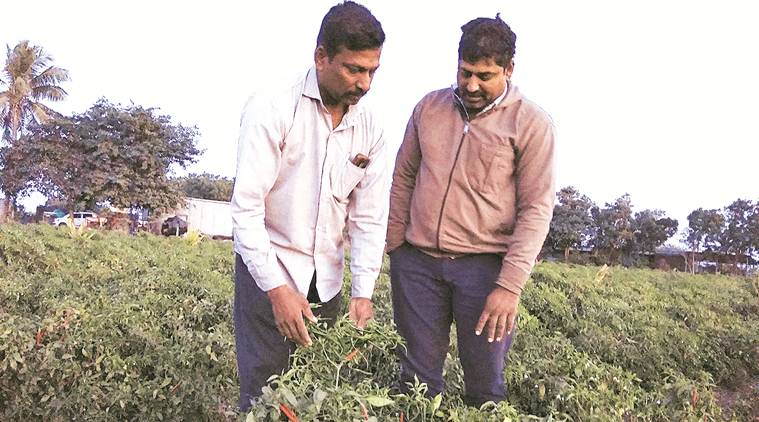- India
- International
Price turnaround: These farmers aren’t crying
Food inflation isn’t a bad thing, at least for onion growers.
 Ashok Pateliya (centre) at his onion field in Kumbhan village of Gujarat’s Bhavnagar district. (Express photo by Gopal Kateshiya)
Ashok Pateliya (centre) at his onion field in Kumbhan village of Gujarat’s Bhavnagar district. (Express photo by Gopal Kateshiya)
AS THE winter sun turns red on the western horizon, Kishor Ranpariya and Haresh Saipariya discuss the overall crop situation and wholesale price trends. The former has just returned after selling 63.51 quintals of onion at the agricultural produce market committee (APMC) mandi in Rajkot, about 25 km from his home in Rataiya village in the district’s Lodhika taluka.
The 63.51 quintals was the 25th and last consignment from around 800 quintals of the bulb that Ranpariya had harvested in the 2019 kharif season and taken to the Rajkot APMC market on Monday. The 49-year-old had graded even these onions; the first lot of 47 quintals fetched a unit price of Rs 2,887, while the remaining 16.51 quintals went for Rs 832 per quintal. After deducting unloading charges at the mandi, his gross realisation was Rs 1.45 lakh.
Read | When farmers turn to play the market
This kharif season was exceptional for Ranpariya, who farms 130 bigha (20.8 hectares) — 30 bigha (4.8 hectares) owned jointly with his brother and 100 bigha (16 hectares) taken on lease. They sowed onion in 40, cotton in 35, groundnut in 30, urad (black gram) in 10, chilli in seven bigha and fodder in the rest of the 130 bigha. At an average yield of 20 quintals/bigha — it could have been 50 quintals, but for an extended monsoon and unseasonal rains in September-October — his total onion harvest was 800 quintals. But the lower produce more than made up through prices, which hit Rs 8,750/quintal for one lot sold in November. His overall onion revenue, at Rs 35 lakh, was the highest ever for a farmer of Rataiya from any crop in a single season!
But it wasn’t just onions.
Ranpariya has also harvested some 200 quintals of groundnut and 140 quintals of cotton. He has already sold 140 quintals of the former to a private oil miller at Rs 5,150/quintal, while awaiting his turn for government agencies to take the balance 60 quintals at the official minimum support price of Rs 5,090. The 140 quintals of kapas (raw un-ginned cotton) he has, however, held back. “The rates are Rs 5,250/quintal now, but rising, and I see them touch Rs 7,000 by March-end. Why sell now?” quips this farmer who has studied only till Class III.
 Kishor Ranpariya (left) and his friend Haresh Saipariya on the former’s chilli field at Rataiya village near Rajkot. (Express photo by Gopal Kateshiya)
Kishor Ranpariya (left) and his friend Haresh Saipariya on the former’s chilli field at Rataiya village near Rajkot. (Express photo by Gopal Kateshiya)
Ranpariya has also grossed Rs 70,000 from his 12 quintals of urad and Rs 3.5 lakh from 300 quintals of green chilli. His chilli crop is yet to be fully harvested. Some of it, depending on the price, would be dried for sale as red chilli till March. “My overall chilli realisation should be Rs 8 lakh and total kharif sales over Rs 60 lakh or Rs 30 lakh net of expenses. It’s mainly thanks to onion,” he sums up.

Ranpariya planted onion for the first time in the rabi (winter-spring) season of 2016-17 and followed it up in kharif 2017, rabi 2018-19 and kharif 2019. “Growing it is a gamble, as prices are volatile. The cultivation cost, too, can go up to Rs 25,000 per bigha, as it did this time due to lack of rain initially that led my first two sowings failing. But when prices are good, all your losses can be made good by one crop,” says this farmer, who is also growing the bulb on 7 bigha in the current rabi season, in addition to wheat on 50 and dhaniya (coriander) on 22 bigha.
Ranpariya has two smart-phones, on which he has installed mobile apps such as ‘Agriscience Krishi’ and ‘Gujarat Kheti’. Besides, he is part of two WhatsApp groups, one run by a nephew who works with a trader at the Rajkot APMC and another administered by Haresh Saipariya. The latter, a 40-year-old Class IX-pass, has attended workshops conducted by Junagadh Agricultural University’s Main Dry Farming Research Station near Rajkot and is in regular touch with scientists.
“Mobile technology enables me to get daily market price updates and information on new varieties or cropping techniques. But my planting decisions are guided as much by study of market trend as gut feeling. Most crops give not more than Rs 20,000 per bigha return. Saipariya and I always look for one crop in a season that can give Rs 50,000-1,00,000. For this kharif, we saw onion as offering good scope for making money,” notes Ranpariya, who handles marketing, while his younger brother supervises the labourers working on their fields.
Ranpariya ploughs back most of the profits from agriculture into his farm and also has some real estate investments in Rajkot city. His son, who is pursuing a bachelor in computer application degree, does the filling up of forms for availing crop insurance and other government scheme benefits. “I can probably earn more by being a civil works contractor or property investor. But I am ultimately a farmer attached to the soil. What I want to be is a farmer who takes initiative and informed decisions,” he tells The Indian Express.
Ranpariya is not the only farmer today making hay from an ongoing agricultural price recovery — and doing better than those in the real estate or construction business.
About 200 km from Rataiya is Kumbhan. There’s no farmer in this village of Bhavnagar district’s Mahuva taluka who does not sow rabi onion. Some cultivate it even in kharif along with other vegetables, cotton and groundnut.
Bala Kapadiya (60) planted onion in four out of his 60-bigha holding this kharif. His per-bigha yield, at 15 quintals, was below Ranpariya’s 20 and even his own normal of 60 quintals. Yet, he has set aside 25 bigha for the crop in the current rabi season — for good reason, given that his kharif onions sold for Rs 5,500/quintal.
The onions produced in Kumbhan are reputed to have special features like deep-red colour, uniform shape and extra pungency. “It has to do with the quality of our soil and groundwater. Traders always pay us Rs 100/quintal more than the highest quoted rate at the Mahuva APMC,” claims Ashok Pateliya, who has planted onion on half of his 20-bigha land this rabi.
The 46-year-old adds: “Black cotton soil is found in many parts of Gujarat. But the layer of that soil in our village is quite thin and beneath it lies a stratum of red murrum. It results in a porous, low moisture-holding soil composition that makes our land ideal for onion”.
That claim is attested by Mayur Goswami, horticulture officer of Gujarat’s Agriculture Department at Mahuva. “Kubhan onion has become a brand similar to the Kesar mango of Talala (in Gir Somnath district), which is attributable to the village’s unique soil, water and climate,” he points out.
Praveen Kathiriya, an onion trader at Mahuva APMC, also concurs: “It helps that Kumbhan’s farmers bring their crop to the market after proper cleaning and grading. Although Kumbhan onion cannot be stored due to higher moisture content, it fetches a premium even in the retail markets of Delhi and Punjab”.
Right now, onion growers are certainly on a roll even if others aren’t.
May 07: Latest News
- 01
- 02
- 03
- 04
- 05





































